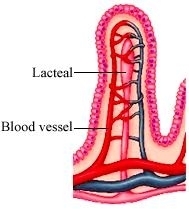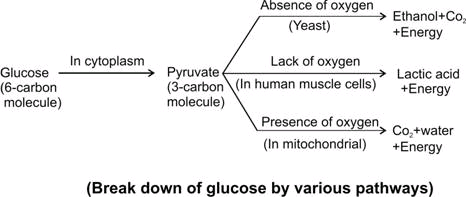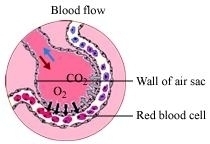NCERT Solution: Life Processes
The inner lining of small intestine has numerous finger-like projections called villi which increase the surface area for absorption. The villi are richly supplied with blood vessels which transport the absorbed food to each and every cells of the body. Where, it is utilized to obtaining energy and repair of old tissues.

The rate of breathing is slower in terrestrial organisms as compared to aquatic organisms. This is due to the fact that in water, the amount of oxygen is less as compared to air while in aquatic organisms the rate of breathing is faster.
Glucose is first broken down in the cell cytoplasm into a three carbon molecule called pyruvate. Pyruvate is further broken down by different ways to provide energy.
The breakdown of glucose by different pathways can be illustrated as follows.

→ Anaerobic Respiration: This process takes place in absence of oxygen, e.g. in yeast during fermentation. In this case pyruvate is converted into ethanol and carbon dioxide.
→ Aerobic Respiration: In aerobic respiration, breakdown of pyruvate takes place in presence of oxygen to give rise 3 molecules of carbon dioxide and water. The release of energy in aerobic respiration is much more than anaerobic respiration.
→ Lack of Oxygen: Sometimes, when there is lack of oxygen, especially during vigorous activity, in our muscles, pyruvate is converted into lactic acid (3 carbon molecule compounds). Formation of lactic acid in muscles causes cramp.
Haemoglobin transports oxygen molecule to all the body cells for cellular respiration. The haemoglobin pigment present in the blood gets attached to four O2 molecules that are obtained from breathing. It thus forms oxyhaemoglobin and the blood becomes oxygenated. This oxygenated blood is then distributed to all the body cells by the heart. After giving away O2 to the body cells, blood takes away CO2 which is the end product of cellular respiration. Now the blood becomes de-oxygenated.
Since haemoglobin pigment has less affinity for CO2, CO2 is mainly transported in the dissolved form. This de-oxygenated blood gives CO2 to lung alveoli and takes O2 in return.

Transportation of O2 and CO2 in blood
The exchange of gases takes place between the blood of the capillaries that surround the alveoli and the gases present in the alveoli. Thus, alveoli are the site for exchange of gases. The lungs get filled up with air during the process of inhalation as ribs are lifted up and diaphragm is flattened. The air that is rushed inside the lungs fills the numerous alveoli present in the lungs.
Each lung contains 300-350 million alveoli. These numerous alveoli increase the surface area for gaseous exchange making the process of respiration more efficient.
The main components of the transport system in human beings are the heart, blood, and blood vessels.
Heart pumps oxygenated blood throughout the body. It receives deoxygenated blood from the various body parts and sends this impure blood to the lungs for oxygenation.
Being a fluid connective tissue, blood helps in the transport of oxygen, nutrients, CO2, and nitrogenous wastes.
The blood vessels (arteries, veins, and capillaries) carry blood either away from the heart to various organs or from various organs back to the heart.
Warm-blooded animals such as birds and mammals maintain a constant body temperature by cooling themselves when they are in a hotter environment and by warming their bodies when they are in a cooler environment. Hence, these animals require more oxygen (O2) for more cellular respiration so that they can produce more energy to maintain their body temperature.
Thus, it is necessary for them to separate oxygenated and de-oxygenated blood, so that their circulatory system is more efficient and can maintain their constant body temperature.
In highly organised plants, there are two different types of conducting tissues - xylem and phloem. Xylem conducts water and minerals obtained from the soil (via roots) to the rest of the plant. Phloem transports food materials from the leaves to different parts of the plant body.